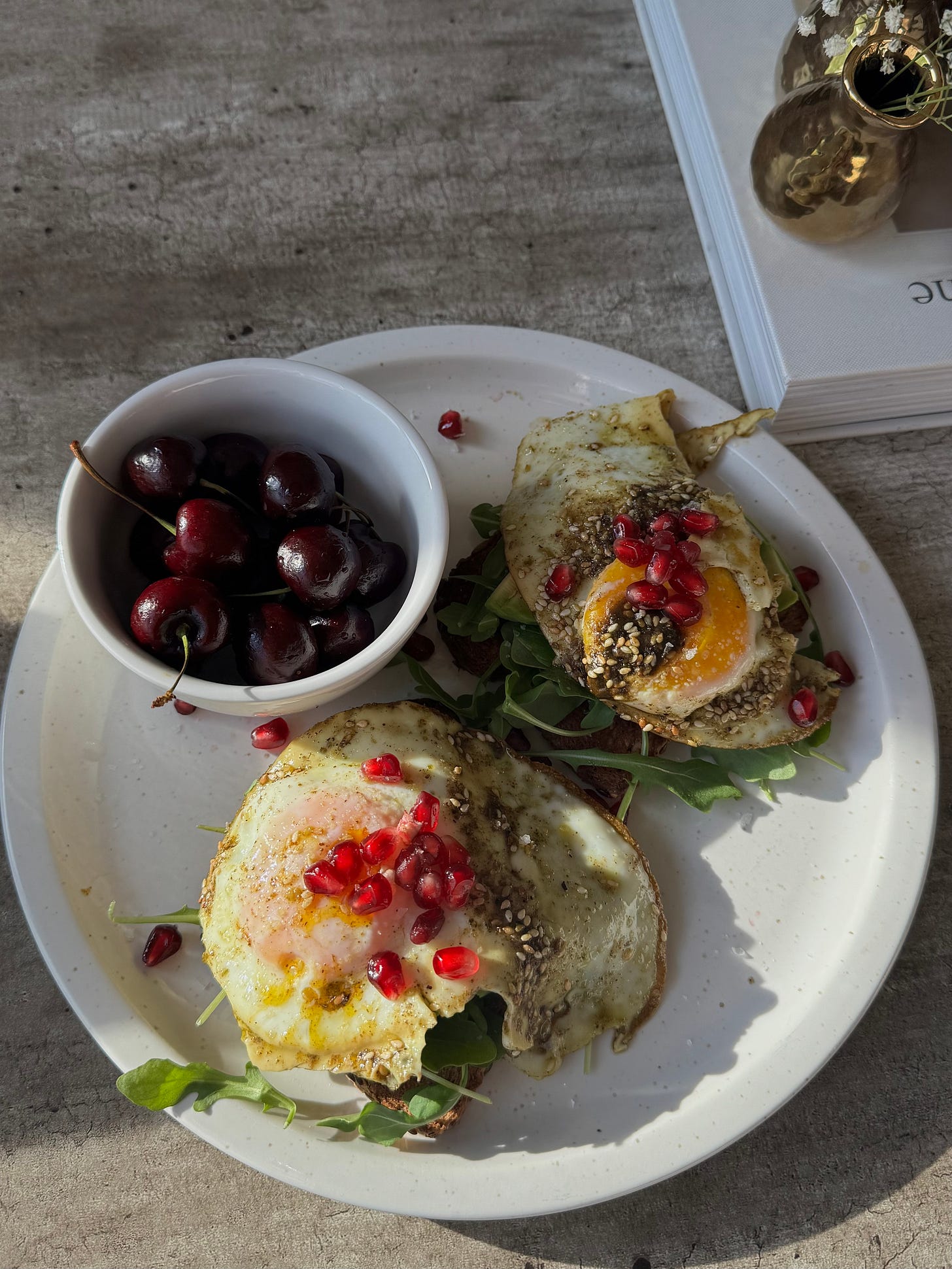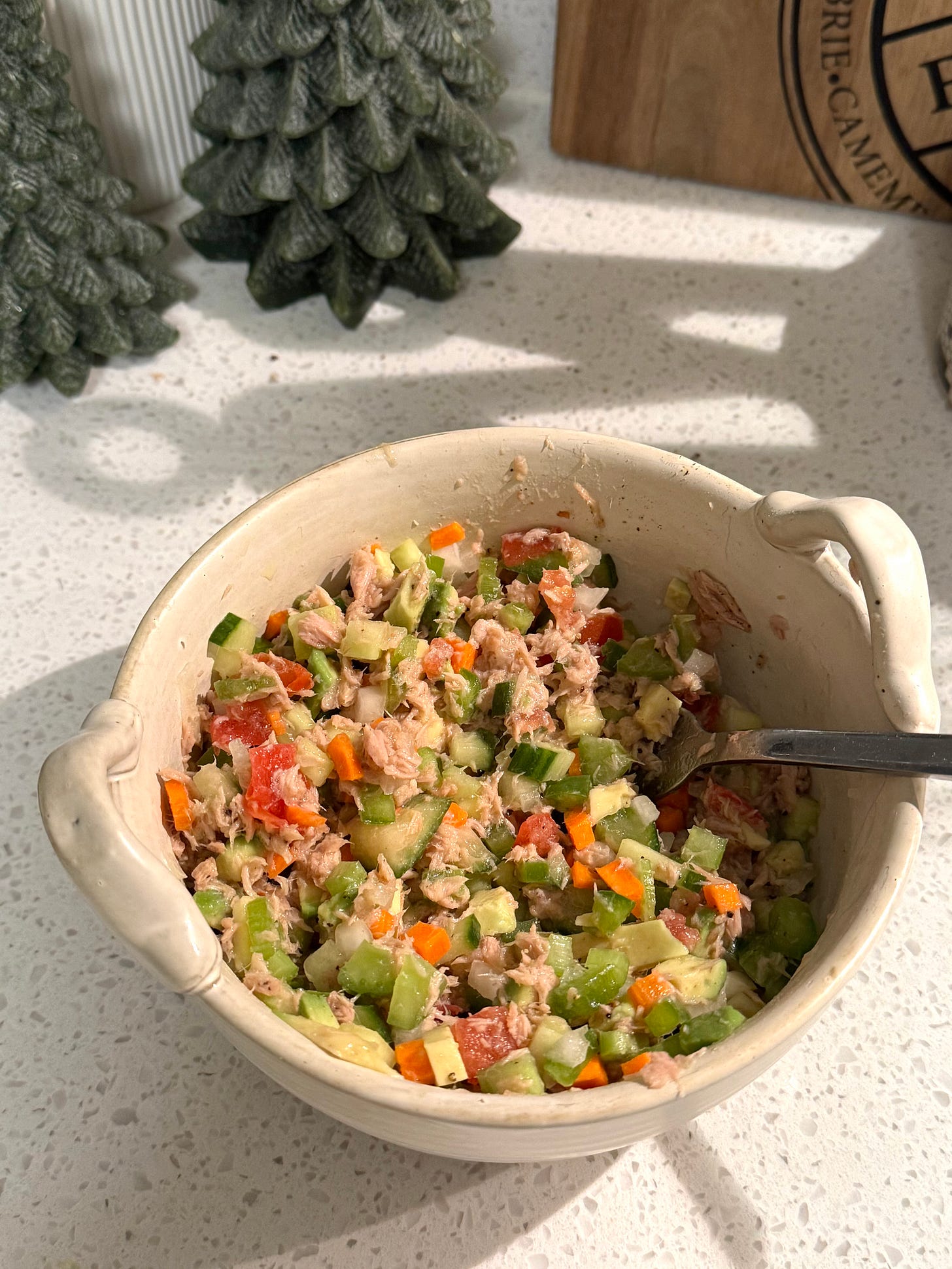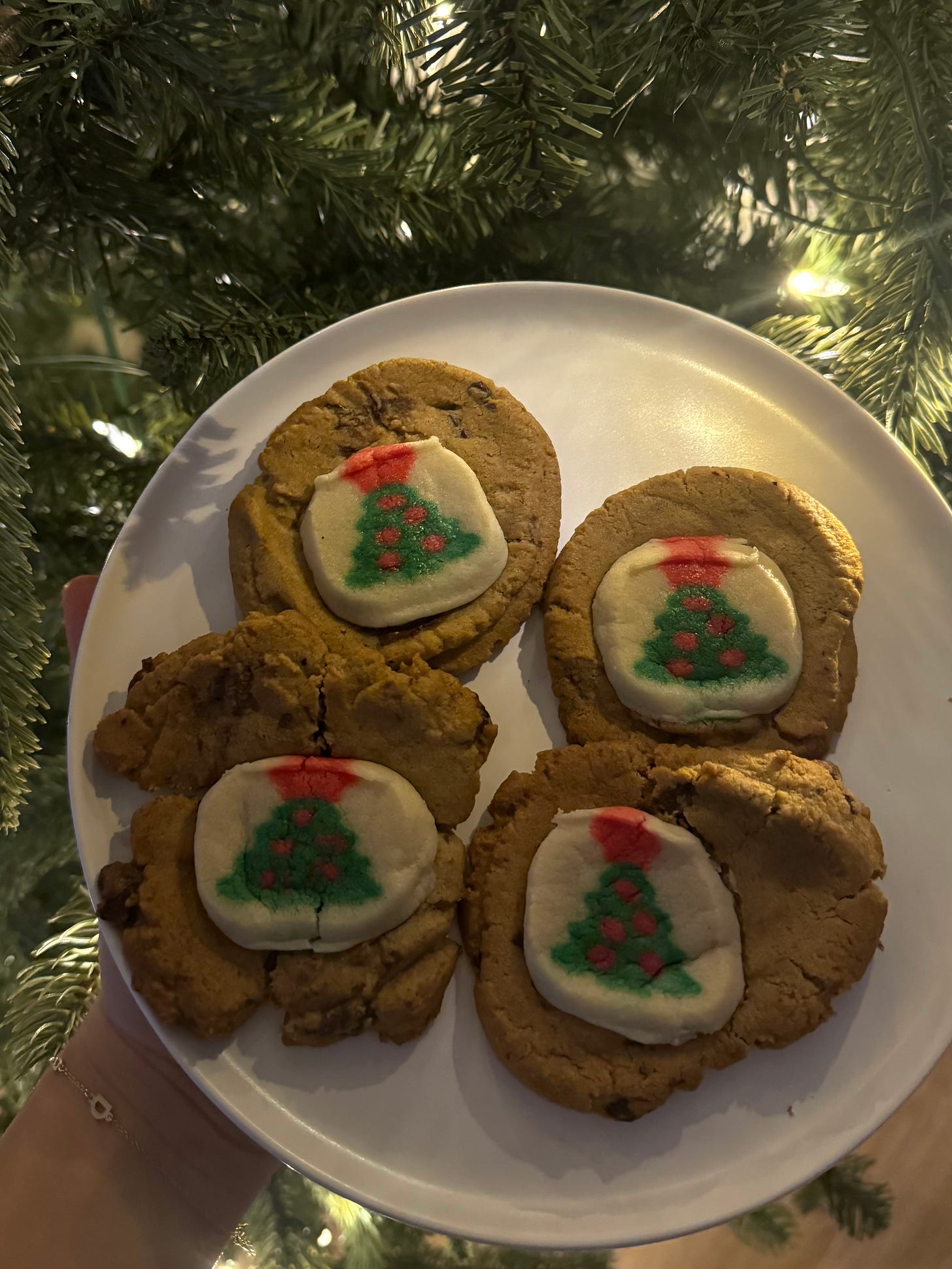What a dietitian eats in a day whose goal is to live to 100
Day 1 of 5: What a dietitian eats in a day and WHY because you should always know the why
If you know me, you know that the infamous “what I eat in a day” videos are not my favorite types of content on the online health and wellness space. When you’re in the dietetics field you see many different scenarios of patients not knowing what to eat, how much to eat, how little to eat, etc - because they are stuck comparing themselves to people on the internet. The majority of people are stuck trying to eat what others are eating because those people “look” like the right way, so that means their diet is inherently perfect.
These videos often create unrealistic expectations, painting a picture of a perfectly curated, aesthetically pleasing diet that doesn't reflect the messy, imperfect reality of most people's lives. They can encourage comparison and guilt, leading viewers to think that if they're not eating exactly like someone else, they're failing. All of these factors together make “what I eat in a day” content more about entertainment or trend-following than actual guidance and nutrition information, which is the most important part.
Ultimately, it reduces eating to a series of aesthetic choices rather than the nourishment it is meant to be, and can reinforce harmful societal ideals about food and body image. So why am I making WIEAD videos if I dislike them? Because I’ve found a way to express it in a right way that’s beneficial to your health. First, instead of giving you one random day of perfect eating, I wanted to film during a week that I know is going to be hard to manage on my end, which will provide you with an even “realer” sneak peak on how a dietitian’s week of eating could look like. Second, instead of just showing you clips in a video, I want to explain the reasonings behind each meal - why I built the meal the way I did. From the macronutrients down to the micronutrients. Lastly, since I’m busy with the holiday season, this is a way for me to make recipe content for you naturally!
This is my way of providing you with educational information regarding health and wellness without making you feel how much WIEAD make people feel. Take all of this information as a way to understand that balance is necessary, fueling & nourishing your body is key for everyday, and there’s more to food than the aesthetics. Nutrition is powerful and that's why I eat the way I eat. We are eating to live to 100.
Welcome to day 1 of my WIEAD video:
*I will always start my with a glass of water and my supplements that I need to take on an empty stomach.*
BREAKFAST (around 9:30AM - 10AM because I never wake up super hungry)
This was roughly 21 grams of protein and 16 grams of fiber
Today I was in the mood for a Middle Eastern inspired breakfast so I made za’atar eggs on toast with pomegranate and avocado.
I know I mentioned that I prioritize fiber and protein in my meals but I also prioritize color. Even though arugula and pomegranate seeds aren’t fiber-dense, they are great sources of color, aka antioxidants. People tend to be hyper focused on the macronutrients (the big picture), that they tend to overlook the micronutrients, which are vital for our health as well. The more color you get in your diet, the more variety of nutrients you’re likely to consume. Each color in fruits and vegetables represents different phyto-chemicals, antioxidants, vitamins, and minerals that provide unique health benefits. I will get to this in a bit.
MAIN:
2 eggs: source of protein - protein plays a key role in building muscle, maintaining our immunity, producing hormones, and providing us with energy.
2 slices of Dave’s Killer Good Seed bread: source of carbs and fiber - carbs for energy that our brain and red blood cells need to function optimally and don’t let anyone tell you otherwise. Fiber to support a bowel movement and ensure my blood sugar levels stay stable within my morning. When your blood sugar levels are stable, you’ll avoid a crash in energy!
Za’atar and olive oil: source of healthy fats and micronutrients - olive oil is an excellent source of omega 3 fatty acids that plays a key role in our brain function. Fat is also needed to produce hormones like serotonin, which is key during the winter seasons. Since we’re obtaining less direct sunlight, we’re not obtaining enough vitamin D3, which is needed to regulate our mood. Seasonal affective disorder can occur in vitamin D deficient people, which can lead to temporary depression and low energy levels. So, obtaining vitamin D/omega 3 dense foods during this time is vital. Let’s not forget omega 3 plays an important role in anti-inflammation, helping support our overall well being.
As for za’atar, it’s made of ingredients like sesame seeds and oregano, which I love to incorporate into my diet. The more plants we eat, the more we’re helping build a strong gut.
Avocado: source of healthy fats and fiber - same reasonings as above, fiber to support our digestion, blood sugar regulation, and to feed our gut bacteria sitting in our colon. & healthy fats to support our mood and brain function. Avocados are also a great source of folate, which plays a key role in creating red blood cells - it’s common to find people that have a deficiency in folate, which can lead to anemia, so eating foods high in folate and iron is crucial!
Arugula: source of bitters - I will try my best to start each morning with arugula because it’s a source of bitters. Bitters are going to help stimulate digestion because who doesn’t love a good bowel movement right as they start their day!?
COLOR:
Pomegranate seeds: if there is one color we love, it’s the color red. You can find polyphenols that promote anti-aging, anti-cancer, anti-inflammatory properties in red produce, like anthocyanins.
Cherries: cherries are not only a good source of fiber, but they are also the color red! Red pigments are going to help feed your good gut bacteria, which is what we want. The more good gut bacteria, they more they can serve you and protect your body.
____________________________________________________________________________
COFFEE (around 10:30AM-11AM)
So I don’t hurt anyone or say anything rude :)
I like to use my Nespresso. I’ll either make a hot coffee or iced coffee, and today I went for hot. I added some frothed soy milk. ½ cup of soy milk is an added 4 grams of protein!
____________________________________________________________________________
LUNCH (around 1:30-2:30PM - it depends on my day)
This was roughly 30 grams of protein and 10 grams of fiber (+ 3g fiber per Wasa crisp, I had 3)
Today I was in the mood for some tuna, so I made a Veggie Packed Tuna Salad accompanied with some Wasa flatbreads.
MAIN:
Tuna: source of protein - tuna is an excellent source of protein, 1 5oz can of white albacore tuna is 29 grams of protein. We want protein in each meal, even if there in different amounts during your day, you can have different amounts of protein per meal. My lunch was a bit more protein heavy than my breakfast and that’s ok! Tuna is also a great source of vitamin B6 and B12. B6 is needed for the production of neurotransmitters like serotonin and dopamine, aka our happy hormones. B12 is needed to create red blood cells, so B12 deficiency can lead to anemia, which we don’t want.
Carrot, celery, onion, tomato, cucumber, green bell pepper, avocado: sources of fiber and color - no reasoning behind adding all of these different veggies besides the fact that they’re different colors, which means I’ll be obtaining an array of different antioxidants and phytonutrients! Plus, they are all sources of fiber that will help me stay fuller for longer and support my overall digestion.
Extra virgin olive oil: source of healthy fats - like I mentioned previously, we need healthy fats for blood sugar regulation, our hormonal health, our brain function, etc. I love adding fresh olive oil to foods because it helps our body absorb fat soluble vitamins in our food, like vitamins A, D, E, and K!
Wasa flatbreads: source of carbs - for energy, duh. & they make for a great dipping tool.
____________________________________________________________________________
DRINK OF THE DAY
I’ll usually have a green juice, another shot of espresso (oops), or a tea during the middle of my day. Today I had a hibiscus peach green tea. Green tea is a source of caffeine, but much less than a cup of coffee would be. This ensures that I give my body a boost of energy, without all the caffeine that would affect my quality of sleep.
____________________________________________________________________________
DINNER (around 6:30-8:30PM- it depends on my day)
This was roughly 25 grams of protein and 5 grams of fiber
Tonight I was in the mood for a wholesome, gut healing dinner, so I made my Chicken Noodle Soup recipe.
Instead of breaking down the soup into different components, all I’ll say is that having soups like chicken noodle soup, lentil soup, etc are great to incorporate into your diet because of *broth*. Bone broth specifically makes for a great addition into your diet because of it’s ability to heal. Bone broth contains L-glutamine, which plays an important role in maintaining our gut lining. Our body is a donut and the digestive tract is the hole. We want to make sure nothing in the hole gets into the dough, and vice versa. This is done by maintaining our gut lining integrity, ensuring no toxins, unwanted food particles, waste get into our bloodstream. So, incorporating foods that contain L-glutamine is KEY for our gut health and overall well being.
This is my Quick & Easy Chicken Noodle Soup recipe, which is so easy to make this winter season. It contains chicken for protein, carrots/celery/onion for fiber and color, and pasta for carbs.
____________________________________________________________________________
SOMETHING SWEET
I really don’t like to bake, so I either do a piece of dark chocolate or eat some fruit. But, since it’s the holiday season, I’ve been making the Pillsbury Christmas cookies and I’ll have two of those. No explanation needed.
How did we like Day 1?! Let me know in the comments if you have any questions.
xoxo,
Jasmin D the RD









I love the donut and hole analogy it does make sense, I also imagine it'd be like not wanting the pickle juice from your pickle leak onto your fries and you don't want your fries to make the pickle all greasy either! All in all lol love everything you ate, it all looks easy but delicious to make!
That was the first thing I learned in nutrient metabolism 🤝!! I’m so glad it was helpful